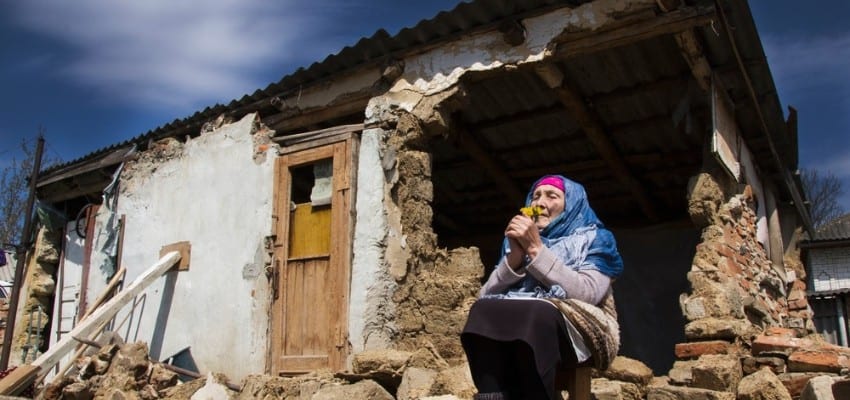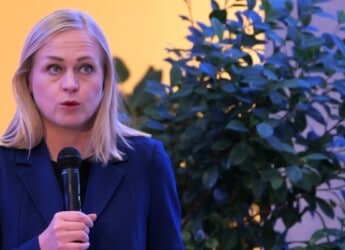|
|
Content Assessment: Mass Graves and Torture Chambers? Ukraine Conflict Assessments in Maps (September 12 - 16, 2022)
Information - 97%
Insight - 95%
Relevance - 92%
Objectivity - 93%
Authority - 95%
94%
Excellent
A short percentage-based assessment of the qualitative benefit of the post highlighting the recent Ukraine conflict assessments in maps from the Institute for the Study of War.
Editor’s Note: One of the most accurate and detailed sources for ongoing updates on the Ukraine crisis is the Ukraine Conflict Update from the Institute for the Study of War. The Institute for the Study of War (ISW) is a 501(c)(3) organization and produces strictly non-partisan, non-ideological, fact-based research. ISW seeks to promote an informed understanding of war and military affairs through comprehensive, independent, and accessible open-source research and analysis. ISW’s research is made available to the general public, military practitioners, policymakers, and media members. Providing a daily synthesis of key events related to the Russian aggression against Ukraine, ISW updates may benefit cybersecurity, information governance, and legal discovery professionals as they follow the business, information technology, and legal trends and trajectories impacted by and stemming from the current Ukraine conflict.
Assessment and Maps*
Ukraine Conflict Assessments – An Overview in Maps
- Institute for the Study of War (ISW), Russia Team
- Critical Threats Project (CTP), American Enterprise Institute
General Assessment Background Info
- ISW systematically publishes Russian campaign assessments that include maps highlighting the assessed control of terrain in Ukraine and main Russian maneuver axes.
- These maps augment daily synthetic products that cover key events related to renewed Russian aggression against Ukraine.
The Russian Offensive Campaign Assessments
- September 16, 2022
- By Katherine Lawlor, Grace Mappes, Mason Clark, and Frederick W. Kagan
Key Development
- The revelations of mass graves of civilians and torture chambers in newly liberated Izyum confirm ISW’s previous assessments that the Bucha atrocities were not isolated war crimes but rather a microcosm of Russian atrocities throughout Russian-occupied areas.
Key Takeaways
- The discovery of mass graves and torture chambers in liberated Izyum confirm previous ISW assessments that the Bucha atrocities were emblematic of Russian activities in occupied areas rather than an anomaly.
- Russian President Vladimir Putin apparently threatened to expand Russia’s attacks on civilian Ukrainian infrastructure if Ukraine continues reported attacks on military facilities in Russia.
- The Ukrainian Resistance Center warned that Russian forces may conduct false flag attacks in occupied areas between September 17 and September 20.
- Ukrainian forces captured all of Kupyansk City on September 16, continuing offensive operations east of the Oskil River.
- Ukrainian forces reportedly shelled targets in Valuyki, Belgorod Oblast, Russia, overnight on September 15-16.
- Ukrainian forces struck Russia’s occupation headquarters in Kherson, likely using HIMARS, and are continuing ground maneuvers in three areas of Kherson Oblast as part of the ongoing southern counteroffensive.
- Russian administrative officials are rallying around Chechen leader Ramzan Kadyrov’s call for “self-mobilization” at a local level to provide additional forces to the Russian military.
- Forced Russian mobilization campaigns are likely depleting male populations in parts of the claimed territory of the Russian proxy Donetsk and Luhansk People’s Republics (DNR and LNR) along the front lines.
- Immediate and coordinated Russian information responses suggest that Ukrainian partisans may not be responsible for the September 16 assassination of the Luhansk People’s Republic (LNR) Prosecutor General and his deputy.
- September 15, 2022
- By Kateryna Stepanenko, Katherine Lawlor, Grace Mappes, George Barros, and Frederick W. Kagan
Key Development
- Ukrainian forces are continuing counteroffensive operations in eastern Ukraine, increasingly pressuring Russian positions and logistics lines in eastern Kharkiv, northern Luhansk, and eastern Donetsk oblasts.
Key Takeaways
- Ukrainian forces continued counteroffensive operations in eastern Ukraine.
- The Kremlin is responding to the defeat around Kharkiv Oblast by doubling down on crypto-mobilization, rather than setting conditions for general mobilization.
- The Kremlin has almost certainly drained a large proportion of the forces originally at Russian bases in former Soviet states since Russia’s full-scale invasion of Ukraine began in February, likely weakening Russian influence in those states.
- Russian and Ukrainian sources reported Ukrainian ground attacks northwest of Kherson City, near the Ukrainian bridgehead over the Inhulets River, and south of the Kherson-Dnipropetrovsk Oblast border.
- Russian-appointed occupation officials and milbloggers claimed that Ukrainian forces conducted a landing at the Kinburn Spit (a narrow peninsula in Kherson Oblast).
- Russian forces conducted limited ground assaults and are reinforcing positions on the Eastern Axis.
- The Russian proxy Donetsk People’s Republic (DNR) is likely attempting to stop its administrators from fleeing ahead of the Ukrainian counteroffensive, demonstrating the bureaucratic fragility of the DNR.
- September 14, 2022
- By Karolina Hird, Kateryna Stepanenko, Katherine Lawlor, George Barros, and Frederick W. Kagan
Key Development
- Wagner Group financier Yevgeny Prigozhin is being established as the face of the Russian “special military operation” in Ukraine.
Key Takeaways
- Wagner Group financier Yevgeny Prigozhin is being established as the face of the Russian “special military operation” in Ukraine.
- Russian forces likely targeted Ukrainian hydrotechnical infrastructure in Dnipropetrovsk Oblast in order to interfere with Ukraine’s ability to operate across the Inhulets River
- The Ukrainian counteroffensive in eastern Kharkiv Oblast continues to degrade Russian forces and threaten Russian artillery and air defenses.
- Russian and Ukrainian sources reported Ukrainian ground attacks in northern Kherson Oblast, western Kherson Oblast, and northwest of Kherson City but did not report any major gains.
- Russian forces continued ground attacks around Bakhmut and northwest and southwest of Donetsk City.
- Funding volunteer battalions is likely placing financial strain on Russian cities and oblasts.
- Russian occupation authorities shut off mobile internet in occupied Luhansk Oblast on September 14, likely to preserve Russian operational security and better control the information environment as Russian forces, occupation officials, and collaborators flee newly-liberated Kharkiv Oblast for Russian and Russian-controlled territories.
- September 13, 2022
- Kateryna Stepanenko, Karolina Hird, Katherine Lawlor, George Barros, and Frederick W. Kagan
Key Development
- The Kremlin acknowledged its defeat in Kharkiv Oblast, the first time Moscow has openly recognized a defeat since the start of the February 2022 invasion of Ukraine. Kremlin officials and state media propagandists are extensively discussing the reasons for the Russian defeat in Kharkiv Oblast, a marked change from their previous pattern of reporting on exaggerated or fabricated Russian successes with limited detail.
Key Takeaways
- The Kremlin has recognized its defeat in Kharkiv Oblast, the first defeat Russia has acknowledged in this war. The Kremlin is deflecting blame from Russian President Vladimir Putin and attributing it instead to his military advisors.
- The Kremlin is likely seeking to use the defeat in Kharkiv to facilitate crypto mobilization efforts by intensifying patriotic rhetoric and discussions about fuller mobilization while revisiting a Russian State Duma bill allowing the military to send call-ups for the regular semiannual conscription by mail. Nothing in the Duma bill suggests that Putin is preparing to order general mobilization, and it is far from clear that he could do so quickly in any case.
- The successful Ukrainian counter-offensive around Kharkiv Oblast is prompting Russian servicemen, occupation authorities, and milbloggers to panic.
- Russia’s military failures in Ukraine are likely continuing to weaken Russia’s leverage in the former Soviet Union as Russia appears unwilling to enforce a violated ceasefire it brokered between Armenia and Azerbaijan or to allow Armenia to invoke provisions of the Russia-dominated Collective Security Treaty Organization in its defense.
- Ukrainian troops likely continued ground attacks along the Lyman-Yampil-Bilohorivka line in northern Donetsk Oblast and may be conducting limited ground attacks across the Oskil River in Kharkiv Oblast.
- Russian and Ukrainian sources indicated that Ukrainian forces are continuing ground maneuvers in three areas of Kherson Oblast as part of the ongoing southern counter-offensive.
- Russian troops made incremental gains south of Bakhmut and continued ground attacks throughout Donetsk Oblast.
- Ukrainian forces provided the first visual evidence of Russian forces using an Iranian-made drone in Ukraine on September 13.
- September 12, 2022
- By Karolina Hird, Grace Mappes, Katherine Lawlor, George Barros, and Frederick W. Kagan
Key Development
- Ukraine’s southern counteroffensive is continuing to have significant impacts on Russian morale and military capabilities in southern Ukraine.
Key Takeaways
- Ukrainian forces are continuing to make impactful gains in Kherson Oblast and are steadily degrading the morale and combat capabilities of Russian forces in this area.
- The Russian military command may be suspending the deployment of newly formed units to Ukraine due to recent Russian losses and overall degraded morale.
- Russian forces are failing to reinforce the new frontline following Ukrainian gains in eastern Kharkiv Oblast and are actively fleeing the area or redeploying to other axes.
- Ukrainian forces continued targeting Russian military assets and positions in Kherson Oblast, likely steadily degrading them.
- The Ukrainian recapture of Izyum has likely degraded Russian forces’ ability to conduct artillery strikes along the Izyum-Slovyansk highway.
- The International Atomic Energy Agency (IAEA) announced the restoration of the second reserve power transmission line to the Zaporizhzhia Nuclear Power Plant (ZNPP).
- Ukraine’s sweeping counteroffensive is damaging Russian administrative capabilities and driving Russian departures from occupied parts of Ukraine far behind the line of contact.
We do not report in detail on Russian war crimes because those activities are well-covered in Western media and do not directly affect the military operations we are assessing and forecasting. We will continue to evaluate and report on the effects of these criminal activities on the Ukrainian military and population and specifically on combat in Ukrainian urban areas. We utterly condemn these Russian violations of the laws of armed conflict, Geneva Conventions, and humanity even though we do not describe them in these reports.
Chronology of Maps from September 12 – 16, 2022 – Mouseover to Scroll
Ukraine Conflict Maps - 091222-091622See the Institute for the Study of War Interactive Map of the Russian Invasion
Read the latest Ukraine Conflict updates from the Institute for the Study of War
* Shared with direct express permission from the Institute for the Study of War (ISW).
About the Institute for the Study of War Research Methodology
ISW’s research methodology relies on both primary and secondary sources, enabling researchers to develop a comprehensive understanding of the situation on the ground. In order to analyze military and political developments in any given area, ISW’s research analysts must wholly understand the systems of enemy and friendly forces. They must also understand the population demographics, physical terrain, politics, and history of that area. This lays the analytical foundation for understanding the reasons for particular developments and fulfilling their assigned research objectives. ISW analysts also spend time in places like Iraq, Afghanistan, and elsewhere in order to gain a better understanding of the security and political situation and to evaluate the implementation of current strategies and policies. Our researchers compile data and analyze trends, producing a granular analysis of developments in areas of research, producing an accurate, high-resolution, timely, and thorough picture of the situation. ISW’s research methodology guarantees its success and commitment to improving the nation’s ability to execute military operations, achieve strategic objectives, and respond to emerging problems that may require the use of American military power.
About the Institute for the Study of War
The Institute for the Study of War advances an informed understanding of military affairs through reliable research, trusted analysis, and innovative education. We are committed to improving the nation’s ability to execute military operations and respond to emerging threats in order to achieve U.S. strategic objectives. ISW is a non-partisan, non-profit, public policy research organization.
Learn more, get involved, and contribute today.
Additional Reading
- [Annual Update] International Cyber Law in Practice: Interactive Toolkit
- Data Embassies: Sovereignty, Security, and Continuity for Nation-States
Source: ComplexDiscovery



























